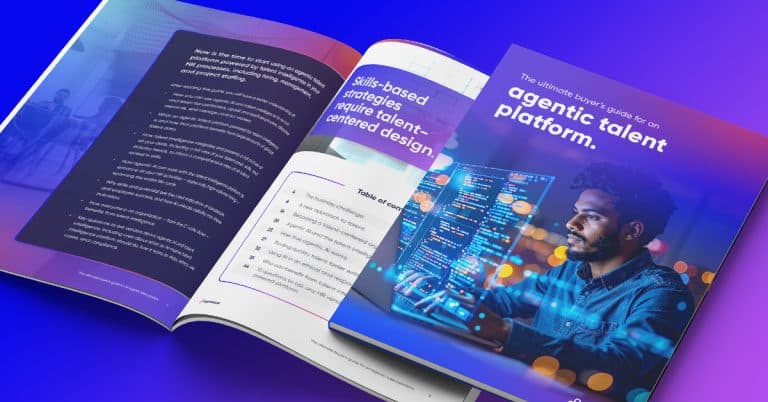
The ultimate buyer’s guide for an agentic talent platform
The ultimate buyer’s guide for an agentic talent platform
Now is the time to start using an agentic talent platform powered by talent intelligence in your HR processes, including hiring, management, and high-volume recruiting.
Skills are still some of the best indicators of capabilities and potential. Now paired with the power of agentic AI, everyone in your organization — from the C-suite down — can see and experience the benefits of talent intelligence in your HR practices and in your business.
After reading this guide, you will have a better understanding of how agentic AI and talent intelligence can help you recruit and retain top performers, upskill and reskill current employees, and expedite your high-volume hiring processes.
You will learn:
- What an agentic talent platform powered by talent intelligence is and how that platform benefits from large amounts of global talent data.
- How talent intelligence integrates and presents a full picture of all your talent data, rooted in skills.
- How agentic AI can enhance your HR activities — especially high-volume hiring — spanning the entire talent life cycle.
- Why skills and potential are still the best indicators of candidate and employee success, and how AI unlocks visibility into these indicators.
- Top questions to ask any vendor about agentic AI in a talent platform.
Today’s business climate is incredibly complex and further complicated by:
Market volatility. Unrelenting changes in the economy, technology, society, and the climate have created a state of flux and compulsory adaptation for organizations. One of the biggest drivers of this change — and new opportunities — is AI. Your organization must be agile and ready to adapt to varying market conditions at a moment’s notice. This requires a deep understanding of your workforce, the labor market, and the competitive landscape.
Skills changing faster than ever.. Leadership remains optimistic about advancements in AI powering the future of work. A third of CEOs said that gen AI has increased revenue and profitability in the past year, with half expecting to increase investments in the technology, according to PwC’s 2025 Annual Global CEO Survey. Increased organizational transformation creates a greater need for finding talent with new and emerging skills — and the capabilities to learn new ones — like working with AI.
Persisting labor challenges. You can’t hire your way out of a labor shortage, especially as technical skills become more specialized. Organizations are turning to skillsbased employment models to help hire for potential, and upskill and reskill employees to build a workforce ready for anything.
Retaining top talent. As you aim to do more with less, spikes in turnover are increasingly expensive — and untenable. The cost of replacing an employee can range from half to two times the employee’s annual salary. As organizations remain hyperfocused on budget, losses in productivity from voluntary turnover and the added strain on remaining employees only compound problems.
Ethical and responsible use of AI. AI is creating new possibilities in how work is done. Ethical and responsible use of AI is possible if you and your vendor understand how to deploy it and mitigate risks.
A new approach to talent.
For years, the operating model in HR has centered on the job. Within this framework, the job and, more specifically, the requisition informed every part of the talent life cycle — who to hire, what they should do, and which programs, policies, practices, and technology to implement.
Organizing around jobs.
The traditional approach to talent planning has centered on the job.
Inputs:
- Job title / job description
- Cost center / department
- Hiring manager
- Location / hire date
Outcomes:
- Inefficiency / rigidity
- HR as order taker
- Mass messaging
- Job-based decisions
- Focus on job title or level
Working from “inside-out” maximizes the exposure of one opportunity to as many candidates as possible.
The typical process went something like this: once a requisition was created, it became HR’s responsibility to fill it. As HR practitioners, it was your responsibility to maximize the exposure of a single job to as many people as possible and find the best candidates to present to the hiring manager — an “inside-out” approach. This process was designed in service of the organization with the hiring manager as the customer.
Once the role was filled, it was on to the next requisition, where you had to start from scratch. In this approach, everything revolved around job descriptions. Employees only did what their job description dictated, and historical data drove decision-making.
Talent-centered design helps reframe the process, the discussion, and, ultimately, the decision. Instead of starting with a job description, this model is built around talent. It uses AI and real-time data to answer questions like: “What is this person interested in?” “What skills do they have?” “How do those skills, interests, and strengths align with our organization’s needs?”
Rather than broadcasting one job to as many people as possible, this method exposes one person to as many opportunities as possible — an “outside-in” approach. Likewise, instead of employees operating within the narrow confines of their job descriptions, talent-centered organizations match a person’s unique skills to projects, gigs, jobs, events, volunteering, and more. While this process is also being done in service of the organization, there is a heavier focus on the talent (applicant/employee) as the customer.
Organizing around talent.
The new approach to talent planning is centered on talent, matching people to opportunities based on their skills and potential.
Inputs:
- Skills / capabilities
- Personas / motivation
- Adjacencies / learnability
- Work preferences / availability
Outputs:
- Speed / agility / synergy
- HR as talent adviser
- Personalization
- Talent-driven decisions
- Focus on work / tasks / skills
Working from the “outsidein” maximizes the exposure of talent to as many opportunities as possible.
This new approach allows for speed and agility rather than inefficiency and rigidity, as it uses real-time data — not historical data — to reveal what someone can do and where to deploy them. It’s also done in the framework of expanding opportunities and identifying all possibilities within an organization, rather than making a decision through the lens of a single job. Instead, you’re finding the best possible fits for your talent to showcase their skills and help them grow.
Even better, with this enhanced visibility into talent, you move from order taker to strategic adviser who can help ensure the organization has the talent and skills it needs for ongoing success.
The ripple effect.
Every HR function — and the entire organization — benefits as a result. Talent acquisition moves from looking at job descriptions to really evaluating people and their skills. Talent managers shift from focusing on performance and promotions to skills-based mobility, succession planning, and proficiencies. HR thought leader Josh Bersin calls this “the big shift” in his research on the postindustrial economy.
By focusing on what someone can do and their learnability instead of degrees or professional experiences, you can broaden the aperture of who qualifies for a role. Even the employee experience benefits as the focus shifts to matching employees to what they love and do best, fostering fulfillment.
The rise of AI-native talent intelligence.
This new approach is possible today because of talent intelligence and its ability to understand skills in real time. Of course, organizations have always known skills were important, but quantifying and describing them wasn’t always simple or easy. Historically, organizations would use a skills taxonomy, or a static listing of skills, to guide talent decisions.
However, the typical skills taxonomy exercise takes months and stalls organizations from making headway in talent initiatives. In the usual indexing process, organizations partner with a consultancy, which can take over a year to generate a skills taxonomy, ontology, and inventory. After several months, organizations receive a spreadsheet report that is virtually outdated from the day it’s created.
This static approach simply can’t keep up with today’s pace of change. Worse, organizations get stuck in this exercise because everything has to be just right for this one-and-done report — for example, legal has to review it, and it has to fit within rigid systems.
You might also like...
Get the latest talent news in your inbox every month
By submitting this form, I consent to Eightfold processing my personal data in accordance with its Privacy Notice and agree to receive marketing emails from Eightfold about its products and events. I acknowledge that I can unsubscribe or update my preferences at any time.
